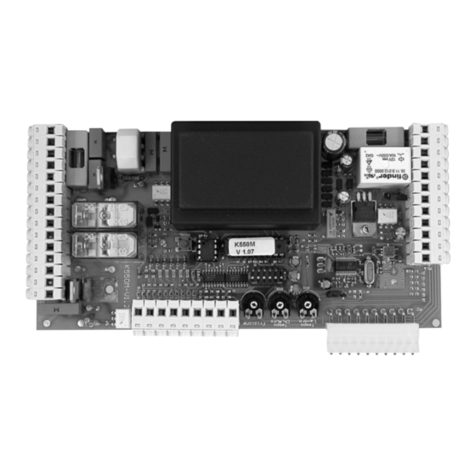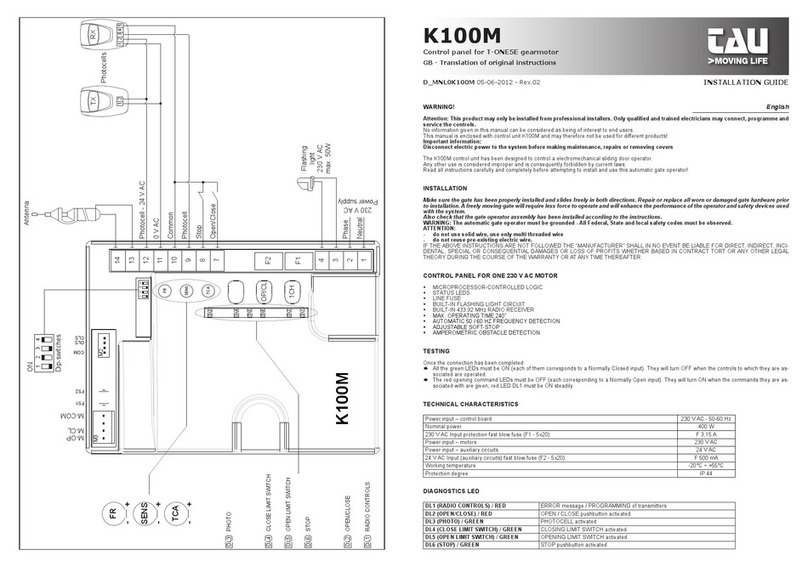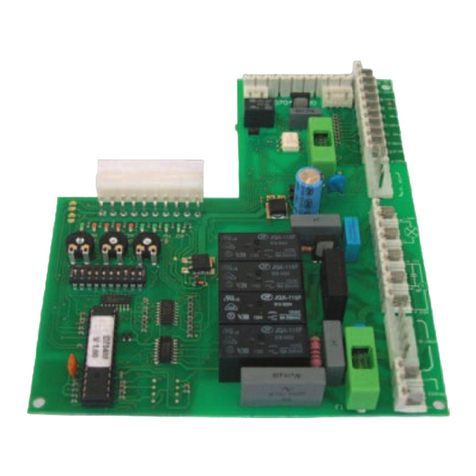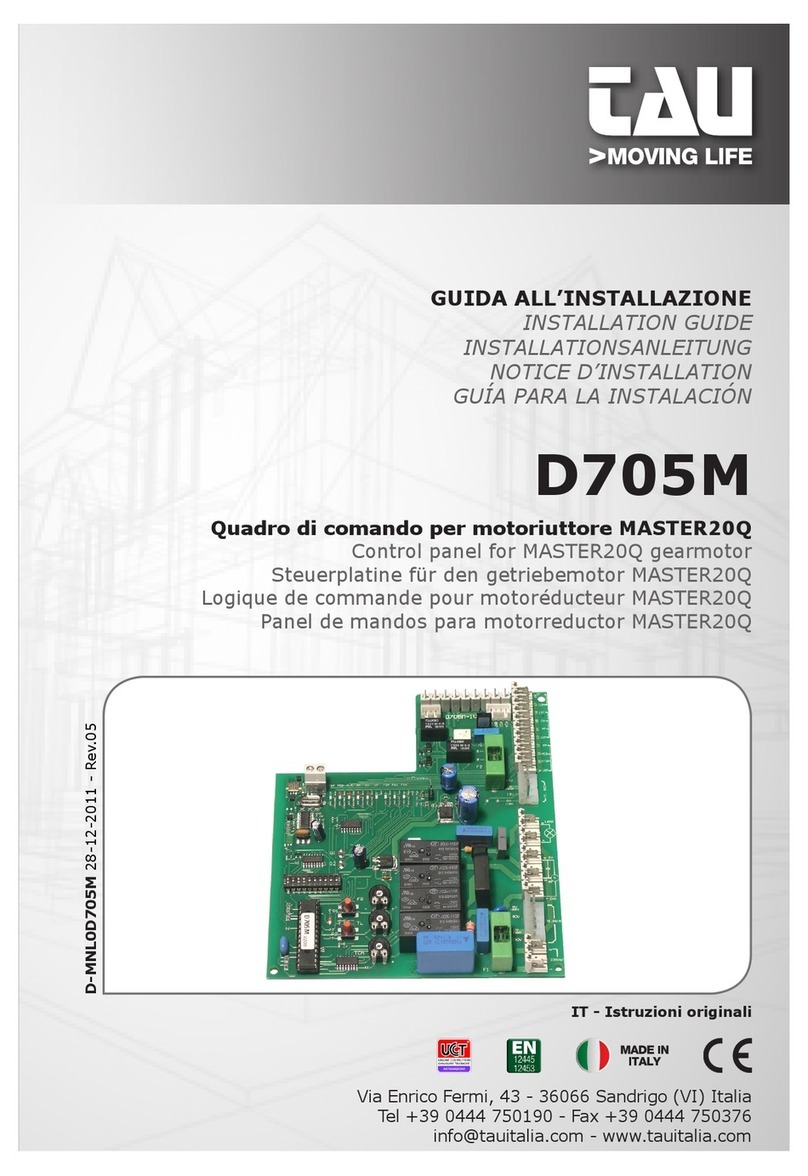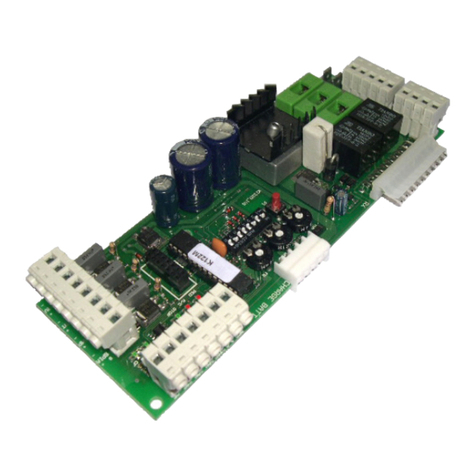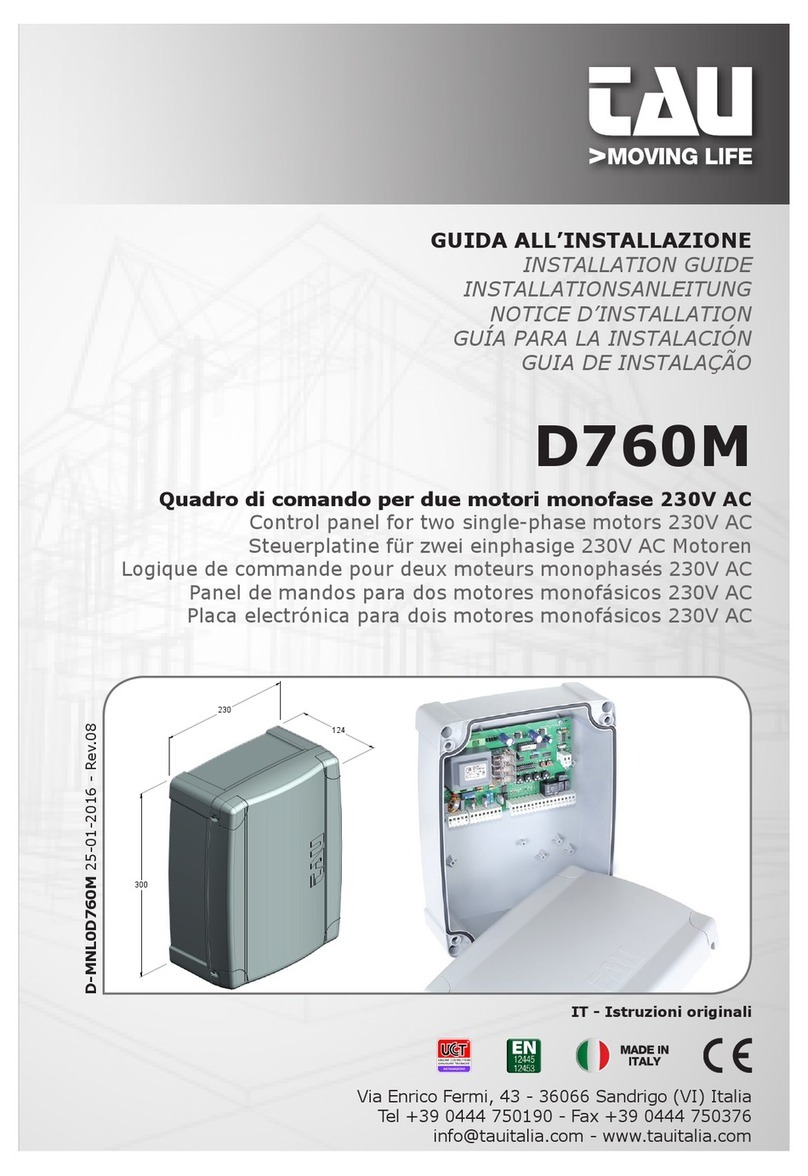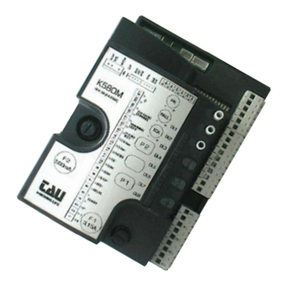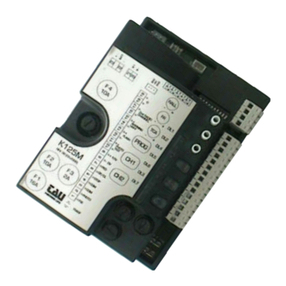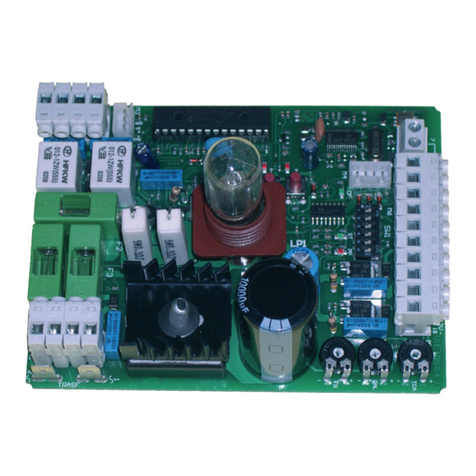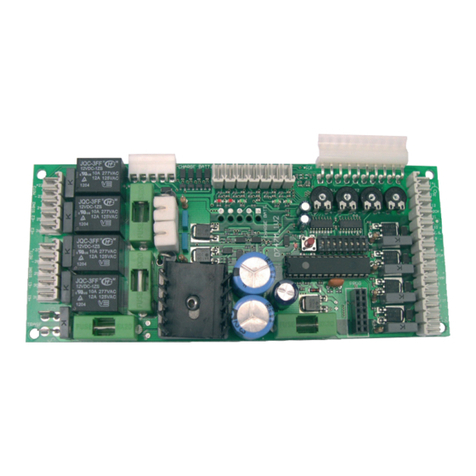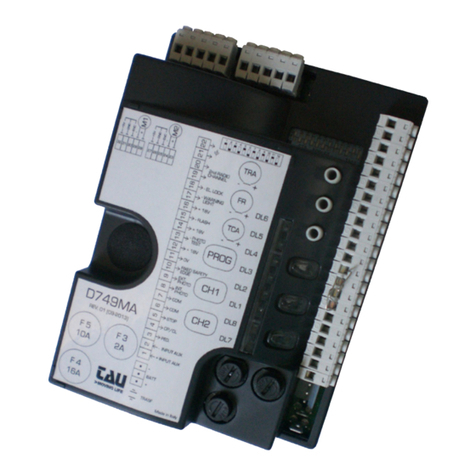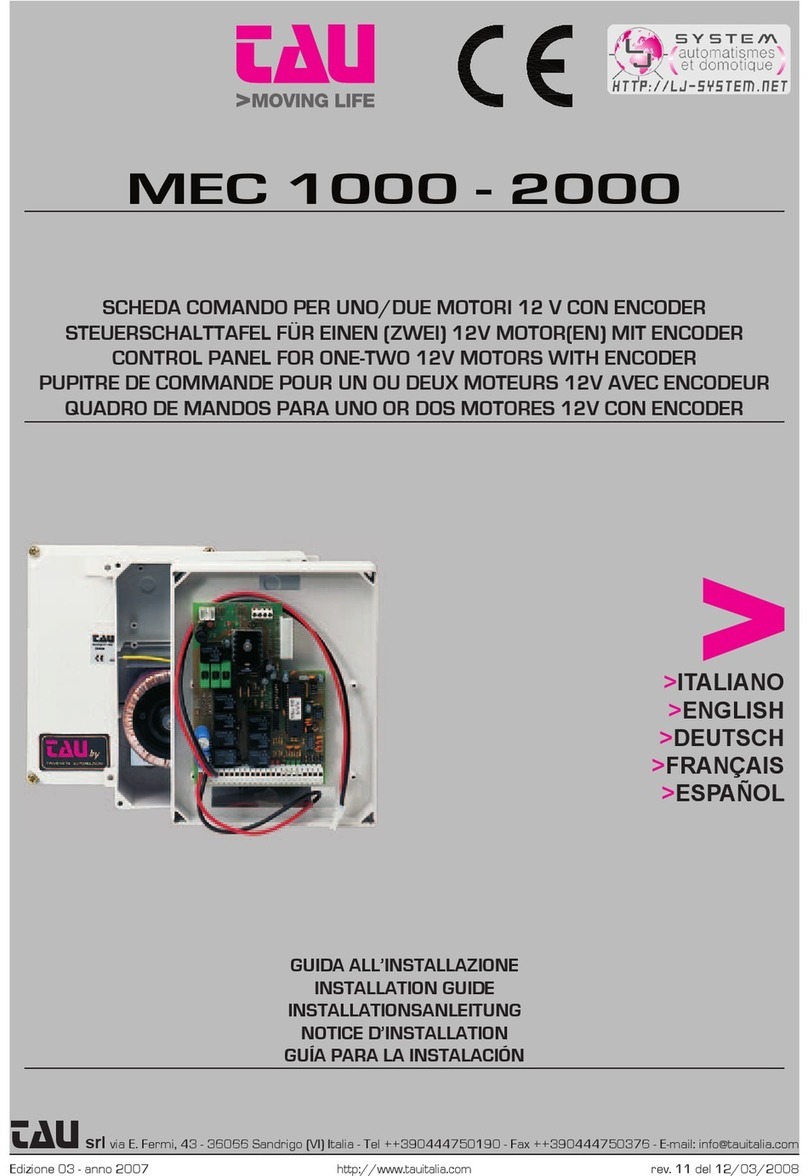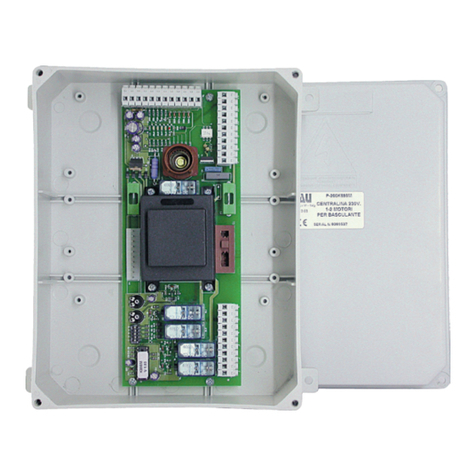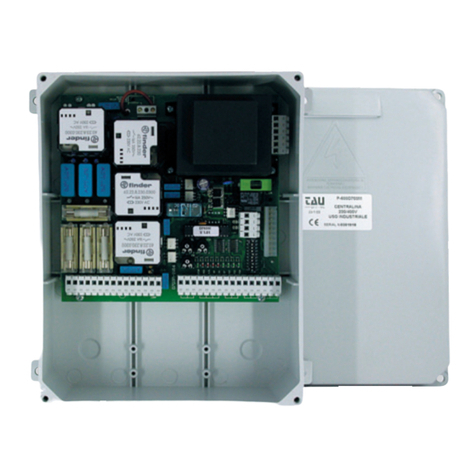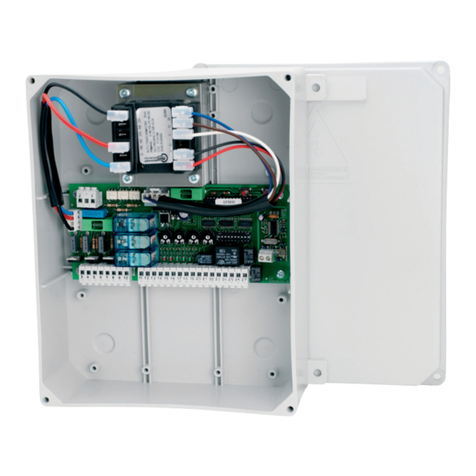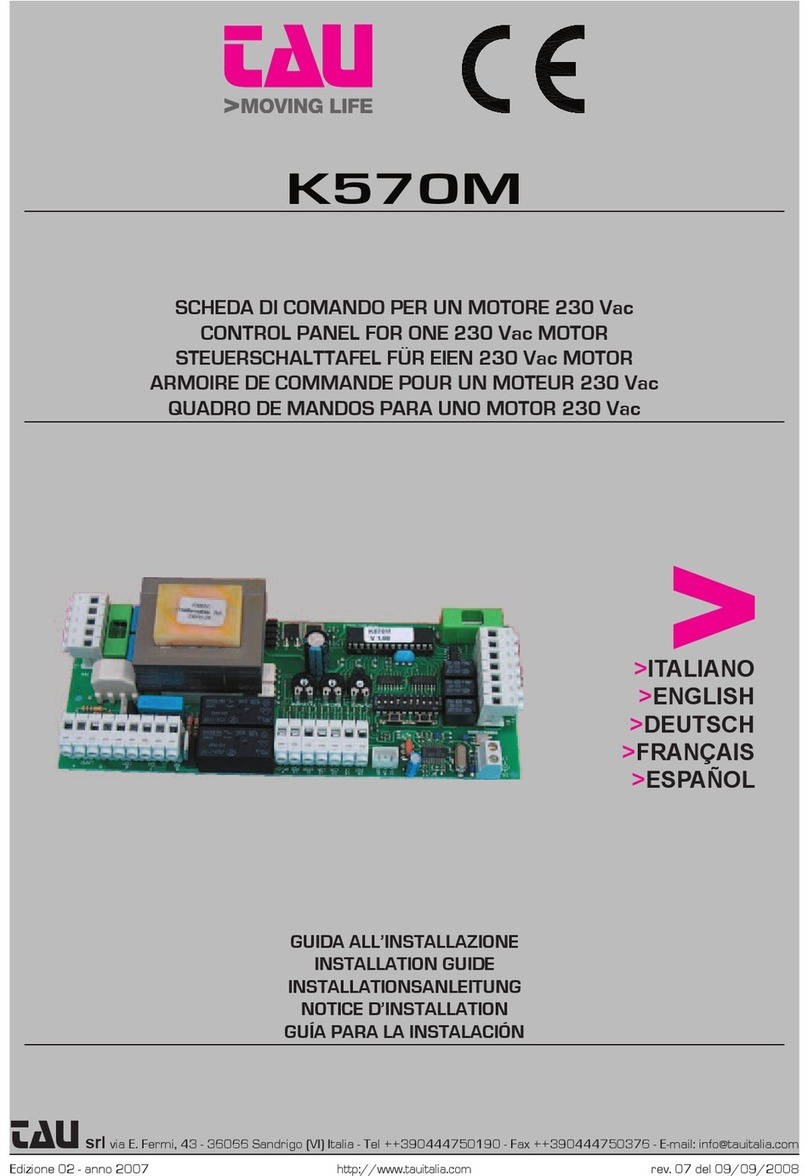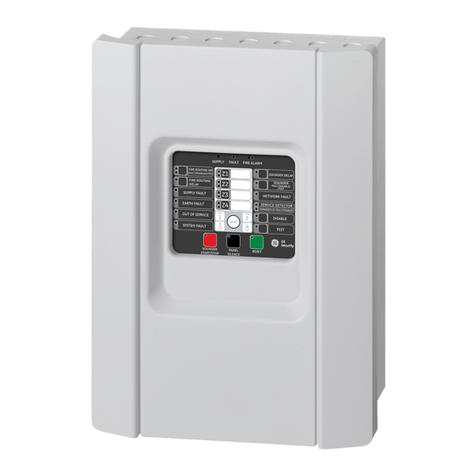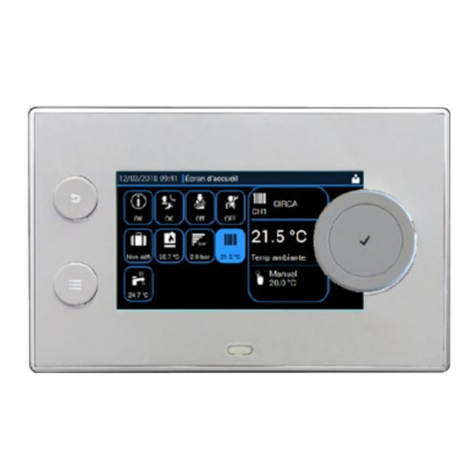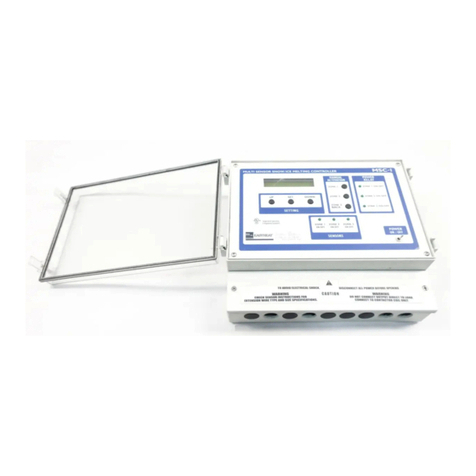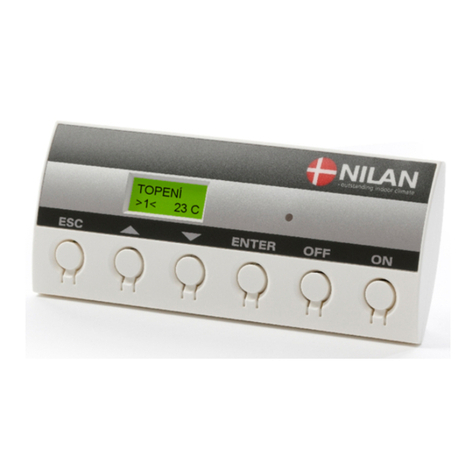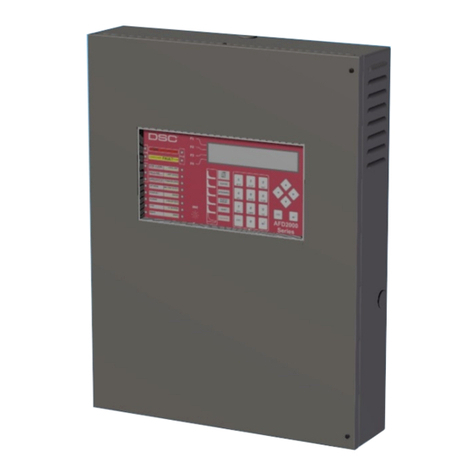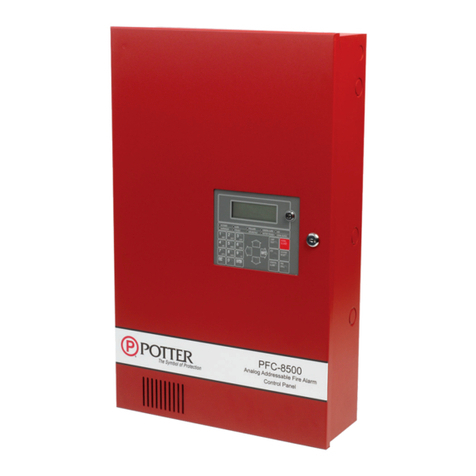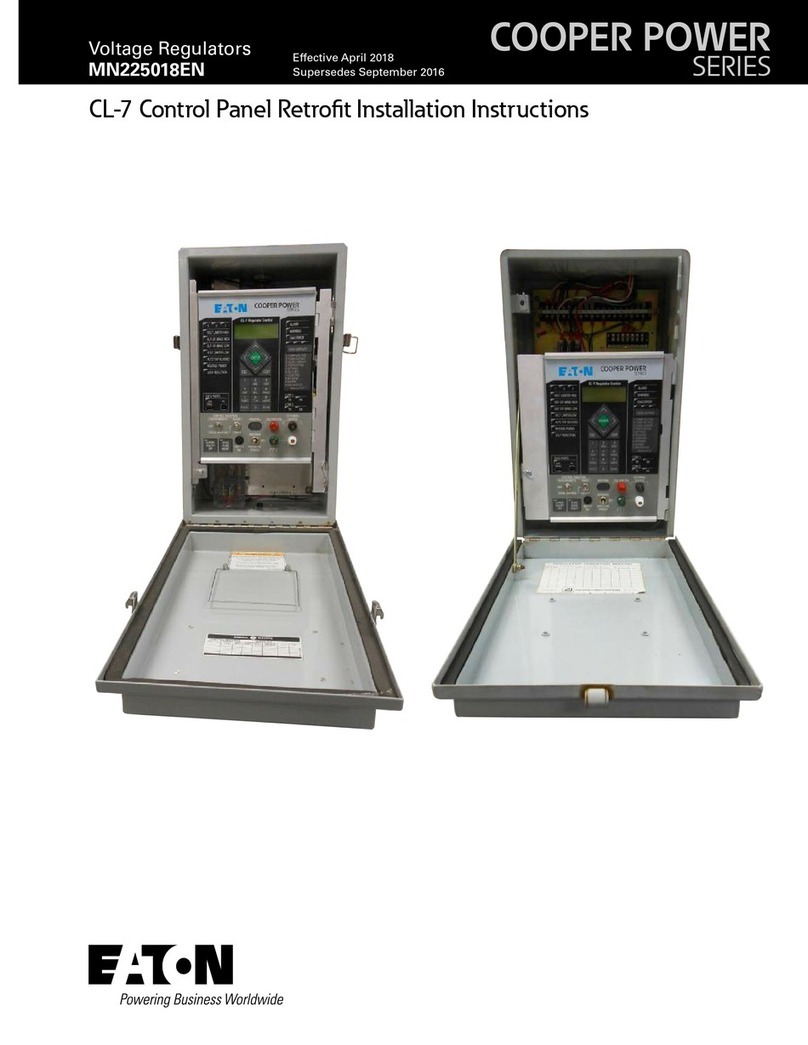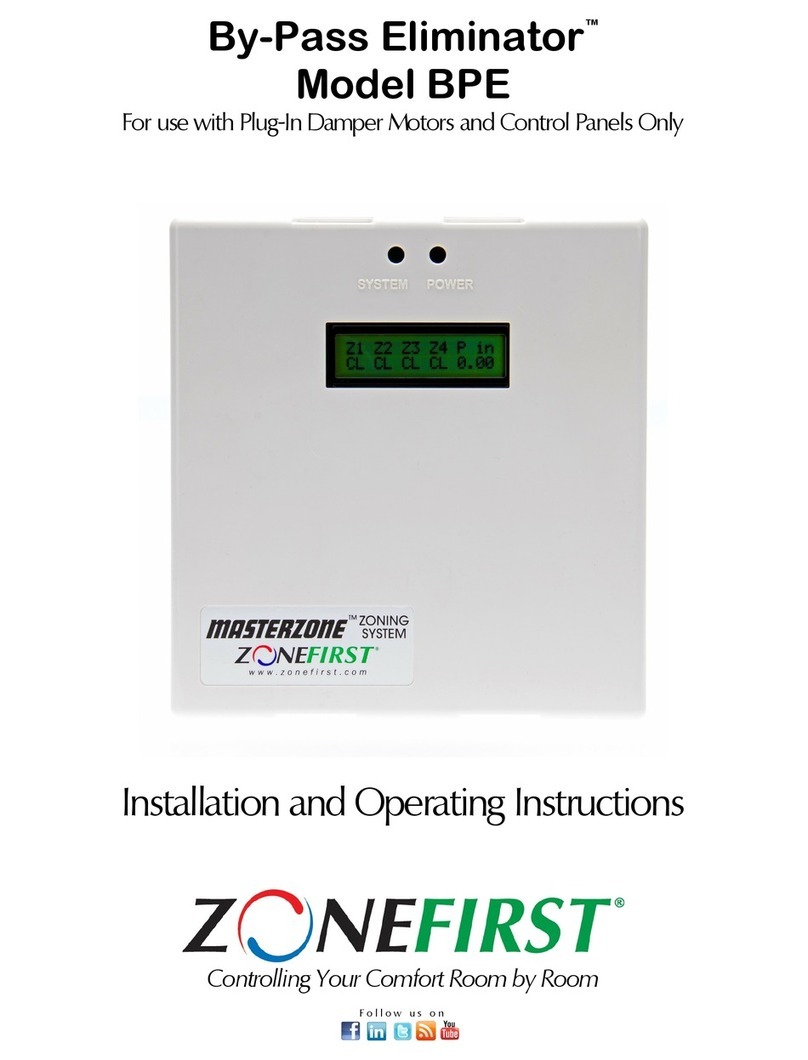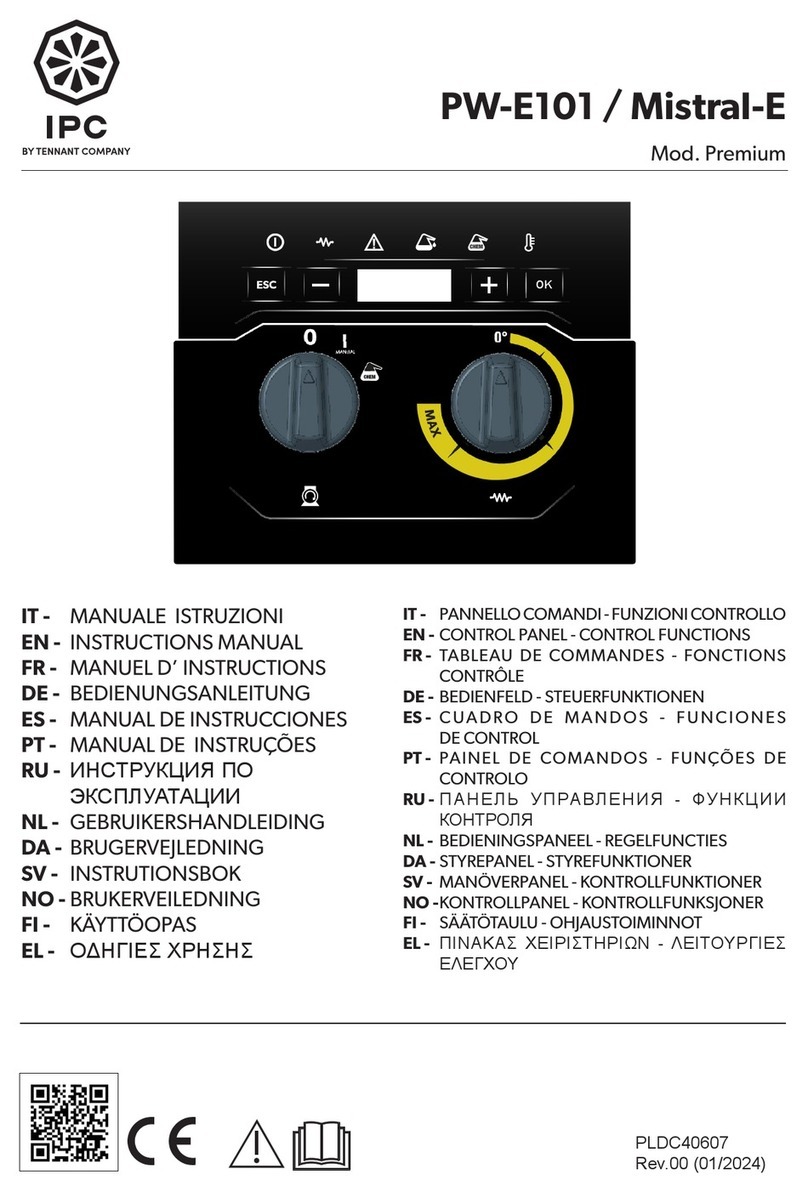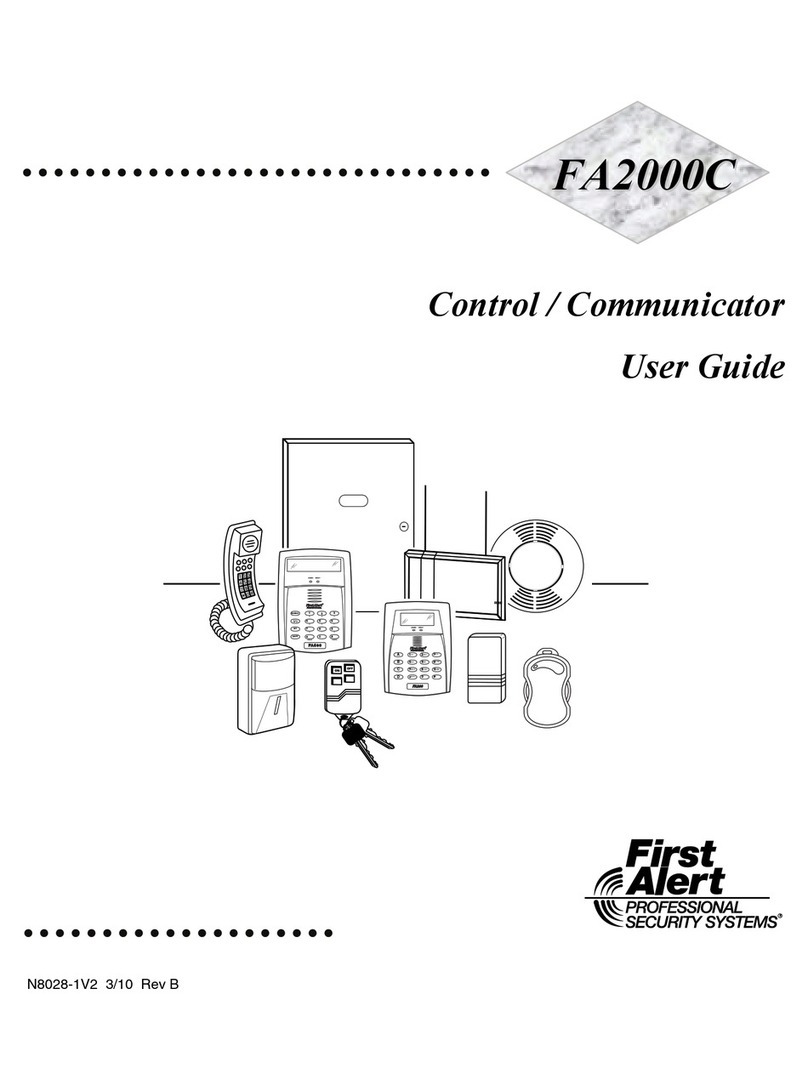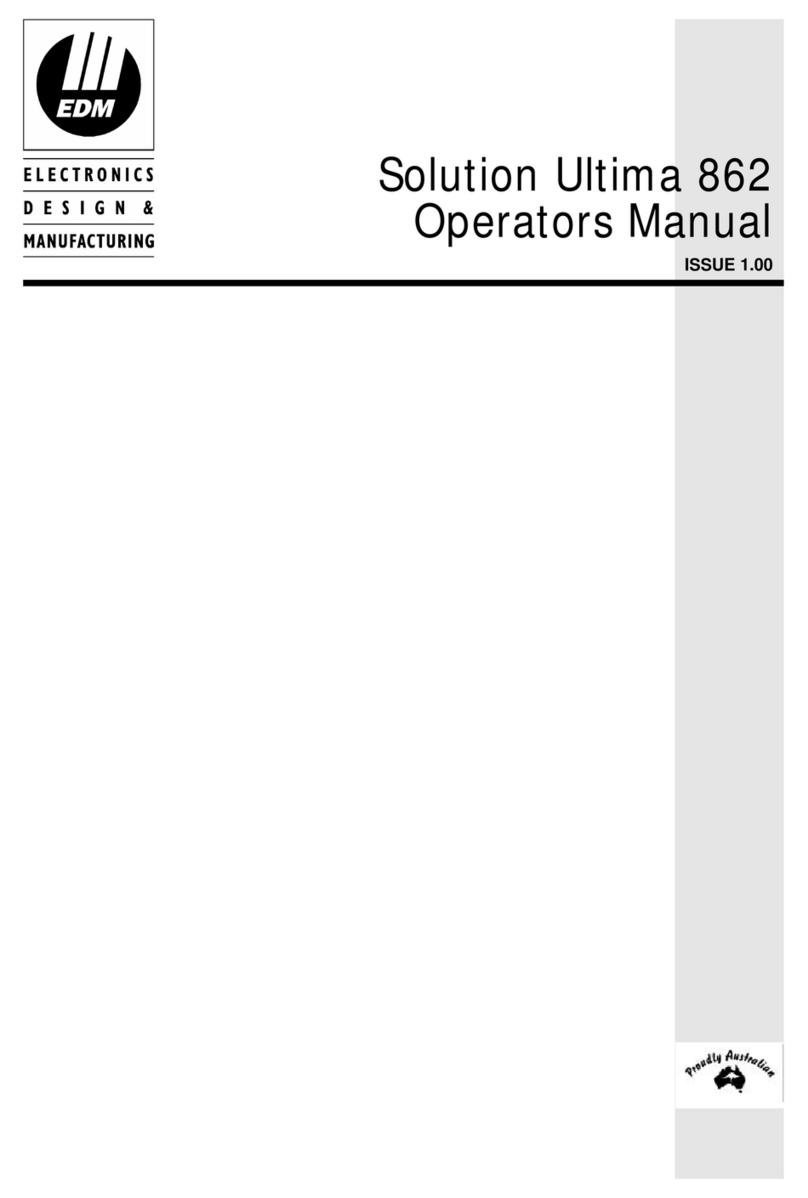tau D747M User manual

1
D747M
GUIDA ALL’INSTALLAZIONE
INSTALLATION GUIDE
INSTALLATIONSANLEITUNG
NOTICE D’INSTALLATION
GUÍA PARA LA INSTALACIÓN
D747M
Quadro di comando per uno/due motori 12V con encoder
Control panel for one-two 12V motors with encoder
Steuerplatine für einen (zwei) 12V Motor(en) mit Encoder
Logique de commande pour un ou deux moteurs 12V avec encodeur
Panel de mandos para uno or dos motores 12V con encoder
Via Enrico Fermi, 43 - 36066 Sandrigo (VI) Italia
Tel +39 0444 750190 - Fax +39 0444 750376
info@tauitalia.com - www.tauitalia.com
IT - Istruzioni originali
D-MNL0D747M 06-11-2012 - Rev.17

2
D747M
SCHEMA CABLAGGIO D747M / D747M WIRING DIAGRAM / SCHALTPLAN DER
DIP-SWITCHES
1 2 3 4 5 6 7 8
ON
OFF
M2 +
-
26 25 24 23 22
ENC2
0V
+5V
M1 +
-
ENC1
0V
+5V
31 30 29 28 27
33 32
~
~F1 (5x20) 16 A
M1
F2 (5x20) 10 A
M2
F3 (5x20) 10 A
+
-~
~
F4 (5x20) 5 A
MICROPROCESSOR
O/C
DL3
O/C
DL3
DIP-SWITCHES
ON
1 2 3 4 5 6 7 8
DL1 DL2 DL4 DL5 DL6
RALL
+-
FRIZ
+-
TCA
+-
TRA
+-
RADIO CONNECTOR
D747M
DL1 DL2 DL4 DL5 DL6
PED O/C STOP IPT EPT
LED's
Ped
O/C
Stop
Common
Common
IPT
EPT
21 20 19 18 17 16 15
11 12 13 147 8 9 103 4 5 61 2
- + - +- + - +- +
LED's
2nd radio
Channel
E.L.
12V 15W
Gate open
warning light
max. 3W
Flashing
light
18 Vdc
max. 20W
Antenna
CHARGE BATT.
O/C =Open/Close
Ped = Pedestrian
Cap = Capacitor
TX = Transmitter
RX = Receiver
E.L. = Electric lock
EPT = External photocells
IPT = Internal photocells
NC = Normally Closed
NO = Normally Open
ENC = Encoder
M = Motor
Internal
Photocells
RX
12345
TX
1 2
External
Photocells
RX
12345
TX
1 2

3
D747M
D747M / SCHÉMA CÂBLAGE D747M / ESQUEMA DEL CABLEADO D747M
DIP-SWITCHES
1 2 3 4 5 6 7 8
ON
OFF
M2 +
-
26 25 24 23 22
ENC2
0V
+5V
M1 +
-
ENC1
0V
+5V
31 30 29 28 27
33 32
~
~F1 (5x20) 16 A
M1
F2 (5x20) 10 A
M2
F3 (5x20) 10 A
+
-~
~
F4 (5x20) 5 A
MICROPROCESSOR
O/C
DL3
O/C
DL3
DIP-SWITCHES
ON
1 2 3 4 5 6 7 8
DL1 DL2 DL4 DL5 DL6
RALL
+-
FRIZ
+-
TCA
+-
TRA
+-
RADIO CONNECTOR
D747M
DL1 DL2 DL4 DL5 DL6
PED O/C STOP IPT EPT
LED's
Ped
O/C
Stop
Common
Common
IPT
EPT
21 20 19 18 17 16 15
11 12 13 147 8 9 103 4 5 61 2
- + - +- + - +- +
LED's
2nd radio
Channel
E.L.
12V 15W
Gate open
warning light
max. 3W
Flashing
light
18 Vdc
max. 20W
Antenna
CHARGE BATT.
O/C =Open/Close
Ped = Pedestrian
Cap = Capacitor
TX = Transmitter
RX = Receiver
E.L. = Electric lock
EPT = External photocells
IPT = Internal photocells
NC = Normally Closed
NO = Normally Open
ENC = Encoder
M = Motor
Internal
Photocells
RX
12345
TX
1 2
External
Photocells
RX
12345
TX
1 2

4
D747M
SCHEDA BATTERIA (OPZIONALE)
BATTERY CHARGER BOARD (OPTIONAL)
BATTERIELADEKARTE (OPTIONAL)
CARTE CHARGEUR DE BATTERIE (EN OPTION)
TARJETA CARGA BATERÍA (OPCIONAL)
F 8A - 5x20 Fusibile rapido 8 Ah 5x20 a protezione della batteria 12 V 7,2 Ah
F 8A - 5x20 8 Ah 5x20 fast-acting fuse for protection of 12 V 7.2 Ah battery
F 8A - 5x20 Schnellsicherung 8 Ah 5x20 zum Schutz der Batterie 12 V 7,2 Ah
F 8A - 5x20 Fusible rapide 8 Ah 5x20 pour la protection de la batterie 12 V 7,2 Ah
F 8A - 5x20 Fusible rápido 8 Ah 5x20 como protección de la batería 12 V 7,2 Ah

5
D747M
1 2 3 4 5 6 7 8
ONOFF
1 2 3 4 5 6 7 8
ONOFF
1 2 3 4 5 6 7 8
ONOFF
255
202
230
101

6
D747M
DICHIARAZIONE DI INCORPORAZIONE DEL COSTRUTTORE
(ai sensi della Direttiva Europea 2006/42/CE AlI. II.B)
Fabbricante: TAU S.r.l.
Indirizzo: Via E. Fermi, 43
36066 Sandrigo (Vi)
ITALIA
Dichiara sotto la propria responsabilità che il prodotto: Centrale di comando
realizzato per il movimento automatico di: Cancelli a Battente
per uso in ambiente: Residenziale / Condominiale
completo di: -
Modello: D747M
Tipo: D747M
Numero di serie: vedi etichetta argentata
Denominazione commerciale: Quadro di comando per uno/due motori 12V con
encoder
È realizzato per essere incorporato su una chiusura (cancello a battente) o per essere assemblato con altri dispositivi
al ne di movimentare una tale chiusura per costituire una macchine ai sensi della Direttiva Macchine 2006/42/CE.
Dichiara inoltre che questo prodotto è conforme ai requisiti essenziali di sicurezza delle seguenti ulteriori direttive
CEE:
- 2006/95/CE Direttiva Bassa Tensione
- 2004/108/CE Direttiva Compatibilità Elettromagnetica
ed, ove richiesto, alla Direttiva:
- 1999/5/CE Apparecchiature Radio e apparecchiature terminali di telecomunicazione
Dichiara inoltre che non è consentito mettere in servizio il macchinario no a che la macchina in cui sarà
incorporato o di cui diverrà componente sia stata identicata e ne sia stata dichiarata la conformità alle condizioni
della Direttiva 2006/42/CE.
Si impegna a trasmettere, su richiesta adeguatamente motivata delle autorità nazionali, informazioni pertinenti sulle
quasi-macchine.
Sandrigo, 31/03/2010
Il Rappresentante Legale
_________________________________________
Bruno Danieli
Nome e indirizzo della persona autorizzata a costituire la documentazione tecnica pertinente:
Loris Virgilio Danieli - via E. Fermi, 43 - 36066 Sandrigo (Vi) Italia
ITALIANO

7
D747M
AVVERTENZE
Il presente manuale è destinato solamente al personale tecnico qualicato per l’installazione.
Nessuna informazione contenuta nel presente fascicolo può essere considerata d’interesse per
l’utilizzatore nale. Questo manuale è allegato alla centralina D747M, non deve pertanto essere
utilizzato per prodotti diversi!
Avvertenze importanti:
Togliere l’alimentazione di rete alla scheda prima di accedervi.
La centralina D747M è destinata al comando di un motoriduttore elettromeccanico per l’automa-
zione di cancelli, porte e portoni.
Ogni altro uso è improprio e, quindi, vietato dalle normative vigenti.
È nostro dovere ricordare che l’automazione che state per eseguire, è classicata come “co-
struzione di una macchina” e quindi ricade nel campo di applicazione della direttiva europea
2006/42/CE (Direttiva Macchine).
Questa, nei punti essenziali, prevede che:
- l’installazione deve essere eseguita solo da personale qualicato ed esperto;
- chi esegue l’installazione dovrà preventivamente eseguire “l’analisi dei rischi” della macchi-
na;
- l’installazione dovrà essere fatta a “regola d’arte”, applicando cioè le norme;
- inne dovrà essere rilasciata al proprietario della macchina la”dichiarazione di conformità”.
Risulta chiaro quindi che l’installazione ed eventuali interventi di manutenzione devono essere
effettuati solo da personale professionalmente qualicato, in conformità a quanto previsto dalle
leggi, norme o direttive vigenti.
Nella progettazione delle proprie apparecchiture, TAU rispetta le normative applicabili al prodot-
to (vedere la dichiarazione di conformità allegata); è fondamentale che anche l’installatore, nel
realizzare gli impianti, prosegua nel rispetto scrupoloso delle norme.
Personale non qualicato o non a conoscenza delle normative applicabili alla categoria dei “can-
celli e porte automatiche” deve assolutamente astenersi dall’eseguire installazioni ed impianti.
Chi non rispetta le normative è responsabile dei danni che l’impianto potrà causare!
Si consiglia di leggere attentamente tutte le istruzioni prima di procedere con l’installazione.
Installazione
Prima di procedere assicurarsi del buon funzionamento della parte meccanica. Vericare
inoltre che il gruppo motoriduttore sia stato installato correttamente seguendo le relative
istruzioni. Eseguiti questi controlli, assicurarsi che il motoriduttore non abbia un assor-
bimento durante il movimento superiore a 3 A (per un corretto funzionamento del quadro
di comando).
L’INSTALLAZIONE DELL’APPARECCHIATURA DEVE ESSERE EFFETTUATA “A REGOLA
D’ARTE” DA PERSONALE QUALIFICATO COME DISPOSTO DAL D.M. 37/08.
NB : si ricorda l’obbligo di mettere a massa l’impianto nonché di rispettare le normative
sulla sicurezza in vigore in ciascun paese.
LA NON OSSERVANZA DELLE SOPRAELENCATE ISTRUZIONI PUÒ PREGIUDICARE IL
BUON FUNZIONAMENTO DELL’APPARECCHIATURA E CREARE PERICOLO PER LE PER-
SONE, PERTANTO LA “CASA COSTRUTTRICE” DECLINA OGNI RESPONSABILITÀ PER
EVENTUALI MAL FUNZIONAMENTI E DANNI DOVUTI ALLA LORO INOSSERVANZA.
ITALIANO

8
D747M
SCHEDA COMANDO PER UNO/DUE MOTORI 12 V CON ENCODER
• LOGICA CON MICROPROCESSORE
• STATO DEGLI INGRESSI VISUALIZZATO DA LEDs
• FUNZIONE “INGRESSO PEDONALE”
• CIRCUITO DI LAMPEGGIO INCORPORATO
•
SENSORE AD ENCODER PER RILEVAMENTO OSTACOLI ED AUTOAPPRENDIMENTO DEL-
LA CORSA
• CONNETTORE PER RICEVENTE
• CONNETTORE PER BATTERIA E CARICA BATTERIA (OPZIONALE)
• DIAGNOSTICA DEL DIFETTO FUNZIONE VISUALIZZATO DA LED
ATTENZIONE:
- non utilizzare cavi unilari (a conduttore unico), es. quelli citofonici, al ne di evitare
interruzioni sulla linea e falsi contatti.
- non riutilizzare vecchi cavi preesistenti.
- si consiglia di utilizzare il cavo TAU cod. M-03000010CO per il collegamento dei moto-
ri alla centrale di comando.
COLLAUDO
A collegamento ultimato:
• I Leds verdi LS devono essere tutti accesi (corrispondono ciascuno ad un ingresso Normal-
mente Chiuso). Si spengono solo quando sono interessati i comandi ai quali sono associati.
• I Leds rossi LS devono essere tutti spenti (corrispondono ciascuno ad un ingresso Normal-
mente Aperto) si accendono solo quando sono interessati i comandi ai quali sono associati.
CARATTERISTICHE TECNICHE
Alimentazione scheda 13,5V AC - 50 Hz
Potenza max. motore 1 c.c. 50 W - 18V DC
Potenza max. motore 2 c.c. 50 W - 18V DC
Fusibile rapido protezione alimentazione ingresso 13,5V AC (F1 - 5x20) F 16 A
Fusibile rapido protezione motore 1 (F2 - 5x20) F 10 A
Fusibile rapido protezione motore 2 (F3 - 5x20) F 10 A
Fusibile rapido protezione ausiliari 18V DC (F4 - 5x20) F 5 A
Tensione circuiti alimentazione motore 18V DC
Tensione alimentazione circuiti dispositivi ausiliari 18V DC
Tensioni alimentazioni circuiti logici 5V DC
Temperatura di funzionamento -20 °C ÷ +55 °C
LED DI DIAGNOSI
DL1 led rosso di segnalazione pulsante PEDONALE
DL2 led rosso di segnalazione pulsante APRE/CHIUDE
DL3 led rosso di segnalazione ERRORI
DL4 led verde di segnalazione pulsante di STOP
DL5 led verde di segnalazione FOTOCELLULA INTERNA
DL6 led verde di segnalazione FOTOCELLULA ESTERNA
ITALIANO

9
D747M
COLLEGAMENTI ALLA MORSETTIERA
Morsetti Funzione Descrizione
1 - 2 AUX uscita ausiliari 18 V DC max. 15 W per fotocellule, relay, rice-
vitori, etc... (1 = NEGATIVO - 2 = POSITIVO)
3 - 4 TX FOTOCELLULE uscita 18 V DC fotocellula trasmittente -fototest- max. nr. 1
trasmettitori fotocellule. (3 = NEGATIVO - 4 = POSITIVO)
5 - 6 LAMPEGGIANTE uscita 18 V DC max. 20W alimentazione lampeggiante, lam-
peggio fornito dalla centrale, veloce in chiusura e lento in
apertura. (5 = NEGATIVO - 6 = POSITIVO)
7 - 8 SPIA CANCELLO
APERTO uscita 18 V DC max. 3W alimentazione spia cancello aperto
e in movimento. (7 = NEGATIVO - 8 = POSITIVO)
9 - 10 ELETTRO
SERRATURA Uscita elettroserratura 12V DC, 15W;
11 - 12 2° CH RADIO
uscita 2° canale radio - per comandare un’altra automazione
o accendere luci, etc... (contatto pulito N.A.)
Nota: per il collegamento di altri dispositivi al 2° canale
radio, quali accensione luci, comando pompe o carichi
importanti, utilizzare un relè ausiliario di potenza con
portata adeguata ai dispositivi da collegare, altrimenti
si potrebbero avere malfunzionamenti dovuti a disturbi
indotti (vedi nota alla ne del paragrafo).
13 - 14 ANTENNA ingresso antenna radioricevente ad innesto.
(13 = SEGNALE - 14 = MASSA);
15 - 17 FOTOCELLULE
ESTERNE
Ingresso FOTOCELLULE O DISPOSITIVI DI SICUREZZA
ESTERNI al cancello (contatto Normalmente chiuso). Il loro
intervento, efcace solo in fase di chiusura, provoca l’arresto
seguito dalla totale riapertura del cancello.
17=COMUNE.
Il trasmettittore della fotocellula deve sempre essere ali-
mentato dai morsetti nr 3 e nr 4, in quanto su di esso
si effettua la verica del sistema di sicurezza (Fototest).
Senza questo collegamento, la centralina non funziona.
Per eliminare la verica del sistema di sicurezza, o quan-
do non si usano le fotocellule, porre il dip-switch nr 6 in
OFF.
16 - 17 FOTOCELLULE
INTERNE
Ingresso FOTOCELLULE O DISPOSITIVI DI SICUREZZA
INTERNI al cancello (contatto Normalmente chiuso). Il loro
intervento, in fase di apertura, provoca l’arresto temporaneo
del cancello no a rimozione dell’ostacolo rilevato; in fase di
chiusura provoca l’arresto seguito dalla totale riapertura del
cancello. 17=COMUNE
18 - 19 STOP ingresso N.C. pulsante STOP - Arresta il cancello dovunque
si trovi, inibendo temporaneamente la chiusura automatica,
se programmata. (18 = COM - 19 = STOP)
18 - 20 APRE/CHIUDE ingresso N.A. pulsante APRE/CHIUDE - Comanda l’apertura
e la chiusura del cancello ed è regolato nel funzionamento
dai dip-switches 2 e 4. (18 = COM - 20 = A/C)
18 - 21 PEDONALE ingresso N.A. pulsante PEDONALE - Comanda l’apertura
e la chiusura totale del motore 1 (M1) ed è regolato nel fun-
zionamento dai dip-switches 2 e 4. (18 = COM - 21 = PED)
22 - 23 MOTORE 2 uscita alimentazione motore 2 (M2) 18 V DC max. 50 W.
24 - 25 - 26 ENCODER (M2) alimentazione e ingresso encoder. (24 = BIANCO segnale -
25 = BLU negativo - 26 = MARRONE positivo)
27 - 28 MOTORE 1 uscita alimentazione motore 1 (M1) 18 V DC max. 50 W
29 - 30 - 31 ENCODER (M1) alimentazione e ingresso encoder. (29 = BIANCO segnale -
30 = BLU negativo - 31 = MARRONE positivo)
ITALIANO

10
D747M
32 - 33 ALIMENTAZIONE ingresso alimentazione scheda 13,5V AC - Alimentato dal tra-
sformatore toroidale e protetto da fusibile sull’alimentazione
230V AC.
IMPORTANTE:
•non collegare relè ausiliari o altri dispositivi all’uscita 18V DC (morsetti 1 - 2) della
centrale, onde evitare di pregiudicarne il buon funzionamento. Utilizzare in alternativa
alimentatori/trasformatori esterni;
•non collegare in prossimità della barriera degli alimentatori switching o apparecchia-
ture similari che potrebbero essere fonte di disturbi;
PROCEDURA DI MEMORIZZAZIONE
ATTENZIONE: Dopo aver alimentato il quadro di comando attendere 2 sec. prima di ini-
ziare a svolgere le manovre di regolazione.
Il cancello deve necessariamente avere i fermi di sicurezza sia in apertura che in chiu-
sura.
Terminata l’installazione dell’automazione:
1_ portare le ante del cancello a 1 m ca. dalla battuta in chiusura;
2_ posizionare il dip-switch nr. 8 in ON;
3_ comandare l’automazione agendo su uno dei seguenti ingressi: A/C, radiocomando o pul-
sante scheda.
4_ il cancello deve cominciare a chiudere.
Nota: nel caso dovesse aprirsi, sospendere la programmazione resettando il quadro elet-
trico (togliere l’alimentazione al quadro per almeno 5 sec. e rimettere il dip-switch nr. 8
in OFF), e quindi, a quadro disalimentato, invertire tra di loro i li di alimentazione del
motore. Riprendere poi la procedura dal punto 1.
5_ effettuata la chiusura, trascorso un tempo di circa 2 sec., viene eseguita automaticamente
un’apertura totale;
6_ ad apertura completata, posizionare il dip-switch nr. 8 in OFF;
7_ l’automazione è ora pronta per il funzionamento.
Effettuare le regolazioni logiche.
Nota: agendo su qualsiasi regolazione del quadro di comando (trimmer o dip-switches) è
necessario effettuare una manovra completa (apertura e chiusura) dell’automazione per
rendere attive le nuove impostazioni.
REGOLAZIONI LOGICHE
TRIMMER
RALL. regolazione distanza di rallentamento: da 10 a 100 cm ca;
T.C.A. regolazione Tempo di Chiusura Automatica: da 3 a 240 secondi ca. (vedi
dip-switch nr. 1);
T.R.A. regolazione tempo di ritardo 2° anta in chiusura: da 2 a 15 secondi;
FRIZ. regolazione sensibilità rilevamento ostacoli.
NOTA: ruotando il TRIMMER FR. in senso orario si diminuisce la sensibilità
del motoriduttore sull’ostacolo e quindi aumenta la forza di spinta; vice-
versa, ruotandolo in senso antiorario, aumenta la sensibilità del motoridut-
tore sull’ostacolo e diminuisce la forza di spinta.
Dip switch
1CHIUSURA
AUTOMATICA
On ad apertura completata, la chiusura del cancello è automatica tra-
scorso un tempo impostato sul trimmer T.C.A.;
Off la chiusura necessita di un comando manuale;
22 / 4 TEMPI
On ad automazione funzionante, una sequenza di comandi di apertura/
chiusura induce il cancello ad una APERTURA-CHIUSURA-APER-
TURA-CHIUSURA, etc.
Off nelle stesse condizioni, la stessa sequenza di comandi induce il can-
cello ad una APERTURA-STOP-CHIUSURA-STOP-APERTURA-
STOP, etc. (funzione passo-passo) (vedi anche dip switch 4);
ITALIANO

11
D747M
3SELEZIONE
MOTORI
On è abilitato l’uso di un solo motore (M1);
Off è abilitato l’uso di 2 motori;
4NO
REVERSE
On il cancello si comporta come stabilito dal dip switch nr. 2;
Off il cancello ignora i comandi di chiusura durante l’apertura e durante il
tempo di chiusura automatica. L’ingresso A/C funziona, dunque, solo
da comando di apertura.
5PRE-
LAMPEGGIO
On la funzione prelampeggio è inserita;
Off la funzione prelampeggio è disinserita;
6FOTOTEST
On la funzione “verica delle fotocellule” è inserita;
Off la funzione “verica delle fotocellule” è disinserita. N.B.: da utilizzare
quando non si usano le fotocellule;
7RICHIUDE
DOPO
FOTOCELLULA
On in seguito all’intervento del contatto fotocellula (ingresso 15 - 17),
l’automazione si chiude automaticamente dopo 5 secondi;
Off funzione disinserita;
8MEMO
On si abilitata la funzione di memorizzazione per l’autoapprendimento
della corsa;
Off posizione in cui lasciare il dip-switch al termine della procedura di
memorizzazione.
APERTURA E CHIUSURA COMANDATA DA OROLOGIO
É possibile comandare l’apertura e la chiusura del cancello mediante un orologio digitale che in
uscita disponga di un contatto relè.
Sarà sufciente collegarlo ai morsetti 18 - 20 (pulsante APRE/CHIUDE) e programmarlo in
modo che, all’ora di apertura desiderata, il contatto relè dell’orologio si chiuda sino all’ora di
chiusura voluta (momento in cui il contatto relè dell’orologio si apre nuovamente, permettendo
così la richiusura automatica).
La richiusura automatica deve essere inserita (Dip-switch nr. 1 in ON).
CARATTERISTICHE DELLA D747M
LED - DL3
Il led, oltre ad indicare la presenza dell’alimentazione, segnala eventuali errori con una serie di
lampeggi predeniti:
sempre acceso: funzionamento regolare;
1 lampeggio: tensione della batteria tampone inferiore a 11,3V DC;
Controllare l’alimentazione di rete, caricare la batteria, sostituire la batteria;
2 lampeggi: errore fototest;
Disabilitare fototest (dip-switch 6 in OFF), vericare funzionamento fotocellule e loro collega-
mento;
3 lampeggi: mancanza tensione di rete;
Controllare interruttore magnetotermico (a monte dell’impianto), controllare fusibili;
4 lampeggi: superamento limite max. di corrente;
Picco di eccessivo assorbimento del motoriduttore, controllare l’assenza di ostacoli lungo la cor-
sa del cancello, vericare l’assorbimento di corrente del motore a vuoto e applicato al cancello;
5 lampeggi: assenza segnale encoder / assenza segnale motore;
Controllare cablaggio, vericare encoder tramite TEST-ENCODER (opzionale);
Controllare cablaggio, vericare che il motore giri liberamente alimentato direttamente dalla
batteria, vericare fusibile F2;
6 lampeggi: presenza ostacolo dopo 5 tentativi di chiusura falliti;
Controllare l’assenza di ostacoli lungo la corsa del cancello e la scorrevolezza dello stesso;
ITALIANO

12
D747M
7 lampeggi: non è stata eseguita alcuna procedura di memorizzazione;
Eseguire procedura di memorizzazione.
L’indicazione di più errori viene eseguita con una pausa di 2 sec. tra una segnalazione e l’altra.
Nel caso di 5 interventi consecutivi (durante la stessa manovra di chiusura) da parte dell’enco-
der (rilevazione ostacolo), la centrale apre completamente. Al successivo impulso di comando,
entrerà in fase di corsa rallentata alla ricerca della battuta in chiusura.
SPIA CANCELLO APERTO (18V DC - max. 3W)
La spia cancello aperto, durante la fase di apertura o chiusura dell’automazione, lampeggia in
sincronia con il lampeggiante per rimanere poi ssa al raggiungimento dell’apertura totale. Una
volta completata anche la fase di chiusura, questa si spegne.
La spia cancello aperto ha inoltre la funzione di segnalare:
• fase di programmazione (quando il dip-switch 8 è in ON);
lampeggia in sincronia con il lampeggiante;
• ripristino della tensione di rete
emette una serie di lampeggi per un tempo di 2 sec. ca.;
• presenza di eventuali ostacoli lungo la corsa dell’automazione dopo 5 tentativi di chiusura
falliti;
lampeggia in sincronia con il lampeggiante.
SCHEDA CARICA BATTERIA (OPZIONALE)
Se si possiede la scheda carica batteria, in assenza di rete l’automazione risulta comunque
funzionante. Nel caso la tensione scenda sotto gli 11,3V DC, l’automazione cessa di funzionare
(il quadro di comando rimane alimentato); quando, invece, scende sotto i 10,2V DC, la scheda
sgancia completamente la batteria (il quadro di comando non è più alimentato).
RILEVAMENTO OSTACOLI
La funzione di rilevamento ostacoli (impostabile tramite trimmer FR) intervenendo in fase di
apertura dell’automazione provoca una richiusura della stessa di 20 cm ca., mentre in fase di
chiusura provoca un’apertura totale.
ATTENZIONE: la logica del quadro di comando può interpretare un attrito meccanico per
un eventuale ostacolo.
RALLENTAMENTO
Per evitare che il cancello sbatta alla ne della corsa, è possibile impostare (tramite il trimmer
RALL) il rallentamento in apertura e in chiusura su una distanza variabile da 10 a 100 cm. (ruo-
tando il trimmer in senso orario si aumenta la distanza di rallentamento; viceversa, ruotandolo in
senso antiorario la distanza di rallentamento si accorcia). Si consiglia di impostare la distanza di
rallentamento tenedo conto del peso del cancello e degli attriti meccanici in gioco.
Il pulsante A/C della scheda ha la stessa funzione del tasto APRE/CHIUDE.
RIPRISTINO FUNZIONAMENTO AUTOMATICO
Qualora si renda necessario movimentare manualmente la chiusura o l’apertura del cancello,
azionare lo sblocco manuale. Per ripristinare il normale funzionamento (in automatico), occorre
specicare:
• se il ripristino avviene successivamente ad un black-out (la scheda resta priva di alimen-
tazione per un certo tempo), il cancello entrerà in fase di corsa rallentata alla ricerca della
battuta di chiusura;
• se il ripristino avviene dopo un intervento manuale (senza interruzioni all’alimentazione della
scheda), saranno necessarie 4 o 5 manovre complete per fare riallineare il cancello, durante
le quali non verranno osservati i normali rallentamenti e le conseguenti battute d’arresto.
ITALIANO

13
D747M
MALFUNZIONAMENTI: POSSIBILI CAUSE E RIMEDI
L’automazione non parte
a- Vericare con lo strumento (Multimetro) la presenza dell’alimentazione 230V AC;
b- Vericare che i contatti N.C. della scheda siano effettivamente normalmente chiusi (3 led
verdi accesi);
c- Impostare il dip 6 (fototest) su OFF;
d- Aumentare il trimmer FRIZ al massimo;
e- Controllare con lo strumento (Multimetro) che i fusibili siano integri.
Il radiocomando ha poca portata
a- Collegare l’antenna radio sui morsetti presenti sulla scheda ricevente e non sui morsetti
13-14 della scheda di comando;
b- Controllare che il collegamento della massa e del segnale dell’antenna non sia invertito;
c- Non eseguire giunzioni per allungare il cavo dell’antenna;
d- Non installare l’antenna in posizioni basse o in posizioni nascoste dalla muratura o dal
pilastro;
e- Controllare lo stato delle pile del radiocomando.
Il cancello si apre al contrario
Invertire tra loro i collegamenti del motore sulla morsettiera (morsetti 27 e 28 per M1; mor-
setti 22 e 23 per M2)
ITALIANO

14
D747M
MANUFACTURER’S DECLARATION OF INCORPORATION
(in accordance with European Directive 2006/42/EC App. II.B)
Manufacturer: TAU S.r.l.
Address: Via E. Fermi, 43
36066 Sandrigo (Vi)
ITALY
Declares under its sole responsibility, that the product: Electronic control unit
designed for automatic movement of: Swing Gates
for use in a: Residential / Communities
complete with: -
Model: D747M
Type: D747M
Serial number: see silver label
Commercial name: Control panel for one-two 12V motors with en-
coder
Has been produced for incorporation on an access point (swing gate) of for assembly with other devices used to
move such an access point, to constitute a machine in accordance with the Machinery Directive 2006/42/EC.
Also declares that this product complies with the essential safety requirements of the following EEC directives:
- 2006/95/EC Low Voltage Directive
- 2004/108/EC Electromagnetic Compatibility Directive
and, where required, with the Directive:
- 1999/5/CE Radio equipment and telecommunications terminal equipment
Also declares that it is not permitted to start up the machine until the machine in which it is incorporated or of
which it will be a component has been identied with the relative declaration of conformity with the provisions of
Directive 2006/42/EC.
The manufacturer undertakes to provide, on sufciently motivated request by national authorities, all information
pertinent to the quasi-machinery.
Sandrigo, 31/03/2010
Legal Representative
_________________________________________
Bruno Danieli
Name and address of person authorised to draw up all pertinent technical documentation:
Loris Virgilio Danieli - via E. Fermi, 43 - 36066 Sandrigo (Vi) Italy
ENGLISH

15
D747M
WARNINGS
This manual has been especially written for use by qualied tters. No information given in this
manual can be considered as being of interest to end users. This manual is enclosed with con-
trol unit D747M and may therefore not be used for different products!
Important information:
Disconnect the panel from the power supply before opening it.
The D747M control unit has been designed to control an electromechanical gear motor for au-
tomating gates and doors of all kinds.
Any other use is considered improper and is consequently forbidden by current laws.
Please note that the automation system you are going to install is classi ed as “machine con-
struction” and therefore is included in the application of European directive 2006/42/EC (Ma-
chinery Directive).
This directive includes the following prescriptions:
- Only trained and qualied personnel should install the equipment;
- the installer must rst make a “risk analysis” of the machine;
- the equipment must be installed in a correct and workmanlike manner in compliance with all
the standards concerned;
- after installation, the machine owner must be given the “declaration of conformity”.
This product may only be installed and serviced by qualied personnel in compliance with cur-
rent, laws, regulations and directives.
When designing its products, TAU observes all applicable standards (please see the attached
declaration of conformity) but it is of paramount importance that installers strictly observe the
same standards when installing the system.
Unqualied personnel or those who are unaware of the standards applicable to the “automatic
gates and doors” category may not install systems under any circumstances.
Whoever ignores such standards shall be held responsible for any damage caused by
the system!
Do not install the unit before you have read all the instructions.
Installation
Before proceeding, make sure the mechanical components work correctly. Also check
that the gear motor assembly has been installed according to the instructions. Then
make sure that the power consumption of the gear motor is not greater than 3A (other-
wise the control panel may not work properly).
THE EQUIPMENT MUST BE INSTALLED “EXPERTLY” BY QUALIFIED PERSONNEL AS RE-
QUIRED BY LAW.
Note: it is compulsory to earth the system and to observe the safety regulations that are
in force in each country.
IF THESE ABOVE INSTRUCTIONS ARE NOT FOLLOWED IT COULD PREJUDICE THE
PROPER WORKING ORDER OF THE EQUIPMENT AND CREATE HAZARDOUS SITUA-
TIONS FOR PEOPLE. FOR THIS REASON THE “MANUFACTURER” DECLINES ALL RE-
SPONSIBILITY FOR ANY MALFUNCTIONING AND DAMAGES THUS RESULTING.
ENGLISH

16
D747M
CONTROL PANEL FOR ONE-TWO 12V MOTORS WITH ENCODER
• LOGICS WITH MICROPROCESSOR
• STATUS OF INPUTS SIGNALLED BY LEDs
• “PEDESTRIAN GATE” FUNCTION
• INCORPORATED FLASHING CIRCUIT
• ENCODER SENSOR FOR OBSTACLE DETECTION AND SELF-LEARNING OF TRAVEL
• RECEIVER CONNECTOR
• BATTERY AND BATTERY CHARGER CONNECTOR (OPTIONAL)
• DIAGNOSTICS OF MALFUNCTIONS SIGNALLED BY LED
ATTENTION:
- do not use single cables (with one single wire), ex. telephone cables, in order to avoid
breakdowns of the line and false contacts.
- do not re-use old pre-existing cables.
- we recommend to use the TAU cable code M-03000010C0 to connect the motors to the
control board.
TESTING
When you have completed the connection:
• All the green LS LEDs must be on (each of them corresponds to a Normally Closed input).
The go off only when the controls to which they are associated are operated.
• All the red LS LEDs must be off (each of them corresponds to a Normally Open input). The
light up only when the controls to which they are associated are operated.
TECHNICAL FEATURES
Board power supply 13,5V AC - 50 Hz
Max motor 1 power DC 50 W - 18V DC
Max motor 2 power DC 50 W - 18V DC
Fast acting fuse for protection of input power supply 13,5V AC (F1 - 5x20) F 16 A
Fast acting fuse for motor 1 protection (F2 - 5x20) F 10 A
Fast acting fuse for motor 2 protection (F3 - 5x20) F 10 A
Fast acting fuse for protection of auxiliary circuits 18V DC (F4 - 5x20) F 5 A
Motor power supply circuits voltage 18V DC
Auxiliary device circuits supply voltage 18V DC
Logic circuits supply voltages 5V DC
Operating temperature -20 °C ÷ +55 °C
DIAGNOSTICS LED
DL1 PEDESTRIAN button red LED signal
DL2 OPEN/CLOSE button red LED signal
DL3 ERRORS red LED signal
DL4 STOP button green LED signal
DL5 INTERNAL PHOTOCELL green LED signal
DL6 EXTERNAL PHOTOCELL green LED signal
ENGLISH

17
D747M
TERMINAL BOARD CONNECTIONS
Terminals Function Description
1 - 2 AUX auxiliary circuits output 18V DC max. 15 W for photocells,
relays, receivers, etc... (1 = NEGATIVE - 2 = POSITIVE)
3 - 4 TX PHOTOCELLS 18V DC output for transmitter photocell – phototest - max.
no. 1 photocell transmitters. (3 = NEGATIVE - 4 = POSITIVE)
5 - 6 FLASHING LIGHT
18V DC max. 20 W output for ashing light supply, ashing
signal supplied by the control unit, rapid for closing, slow for
opening. (5 = NEGATIVE - 6 = POSITIVE)
7 - 8 GATE OPEN
WARNING LIGHT
18V DC max. 3 W output for supply to open and moving gate
warning light. (7 = NEGATIVE - 8 = POSITIVE)
9 - 10 ELECTRIC
LOCK 12V AC, 15 W output for electric lock.
11 - 12 2nd CH RADIO
2nd radio channel output - for control of an additional automa-
tion or for switching on lights, etc... (N.O. clean contact)
Warning: to connect other devices to the 2nd Radio
Channel (area lighting, pumps, etc.), use an additional
auxiliary relay (see note at end of paragraph).
13 - 14 AERIAL plug-in radio-receiver aerial input.
(13 = SIGNAL - 14 = GROUND)
15 - 17 EXTERNAL
PHOTOCELLS
PHOTOCELL OR SAFETY DEVICE input OUTSIDE the gate
(Normally Closed contact). Then these devices trigger during
the closing phase, they stop the gate and then totally open it
again. 17 = COMMON.
Note: the photocell transmitter must always be supplied
by terminals no. 3 and no. 4, since the safety system test
(phototest) is carried out on it. Without this connection,
the control unit does not work. To override the testing of
the safety system, or when the photocells are not used,
set dip-switch no. 6 to OFF.
16 - 17 INTERNAL
PHOTOCELLS
PHOTOCELL OR SAFETY DEVICE input INSIDE the gate
(Normally Closed contact). When these devices trigger dur-
ing the opening phase, they temporarily stop the gate until
the obstacle has been removed; during the closing phase
they stop the gate and then totally open it again.
18 = COMMON.
18 - 19 STOP
N.C. input for STOP button – It stops the gate in any position,
temporarily inhibiting its automatic closing, if programmed.
(18 = COM - 19 = STOP)
18 - 20 OPEN/CLOSE
N.O. input for OPEN/CLOSE button - It commands the open-
ing and closing of the gate and its operation is controlled by
dip-switches 2 and 3. (18 = COM - 20 = O/C)
18 - 21 PEDESTRIAN
PEDESTRIAN button N.O. input – Controls the total opening
and closing of motor 1 (M1) and the functioning is regulated
by dip-switches 2 and 4. (18 = COM - 21 = PED)
22 - 23 MOTOR 2 motor 2 (M2) supply output 18V DC max. 50 W.
24 - 25 - 26 ENCODER (M2) encoder supply and input. (24 = WHITE signal - 25 = BLUE
negative - 26 = BROWN positive)
27 - 28 MOTOR 1 motor 1 (M1) supply output 18V DC max. 50 W.
29 - 30 - 31 ENCODER (M1) encoder supply and input. (29 = WHITE signal - 30 = BLUE
negative - 31 = BROWN positive)
ENGLISH

18
D747M
32 - 33 POWER SUPPLY
13,5V AC control unit power supply input – Supplied by the
toroidal transformer and protected by fuses on the 230V AC
power supply.
IMPORTANT:
• Do not connect auxiliary relays or other devices tot he 18 V DC output (terminals 1 – 2)
to avoid malfunctions of the control unit. Use separated power supply / transformers
instead;
• do not connect switching feeders or similar apparatus close to the control unit that
may be a source of disturbance.
MEMORIZATION PROCEDURE
WARNING: After powering the control panel, wait 2 seconds before you start performing
the adjustment operations.
The gate must be equipped with the opening and closing safety stops.
When you have completed the installation procedures :
1_ position the leaf of the gate at approx. 1 m from the closing stop;
2_ set dip-switch no. 8 to ON;
3_ operate the automation using one of the following inputs: O/C, radio control or card button.
4_ the gate must start to close.
If it opens, stop the programming procedure by resetting the electric panel (disconnect
the power supply to the panel for at least 5 sec. and set dip-switch no. 8 to OFF); with
the control panel disconnected, exchange the motor supply wires. Restart the procedure
from point 1.
5_ when the gate has closed, after approximately 2 seconds a complete opening manoeuvre is
executed automatically;
6_ when the gate has opened, set dip-switch no. 8 to OFF;
7_ the automation is now ready for operation.
Make the logic adjustments.
When any adjusting devices (trimmers or dip-switches) on the control panel are operat-
ed, a complete manoeuvre must be carried out in order for the new settings to take effect.
LOGIC ADJUSTMENTS
TRIMMER
RALL. slowdown distance adjustment: from about 10 to 100 cm;
T.C.A. Automatic Closing time adjustment: from about 3 to 240 seconds (see dip-
switch no. 1);
T.R.A. 2nd wing closing delay adjustment from 2 to 15 seconds.
FRIZ. obstacle detection sensitivity adjustment.
NOTE: by rotating the TRIMMER FR. clockwise the sensitivity of the gear-
motor to obstacles diminishes and therefore the thrust force increases;
vice-versa, by rotating it counter-clockwise, the sensitivity of the gearmo-
tor to obstacles increases and therefore the thrust force diminishes.
Dip switch
1AUTOMATIC
CLOSING
On when the gate has opened, it closes automatically after the time es-
tablished through the T.C.A. trimmer;
Off the closing manoeuvre requires a manual command;
ENGLISH

19
D747M
22 / 4 STROKE
On when the automation is operational, a sequence of opening/closing
commands causes the gate to OPEN-CLOSE-OPEN-CLOSE etc.
Off
under the same circumstances, the same sequence of commands
causes the gate to OPEN-STOP-CLOSE-STOP-OPEN-STOP, etc.
(step-by-step function) (see also dip switch 4);
3MOTORS
SELECTION
On enables just one motor (M1);
Off enables 2 motors;
4NO
REVERSE
On the gate behaves as established by dip switch no. 2;
Off
the gate ignores the closing commands during the opening manoeu-
vre and during the automatic closing time. Therefore the A/C input
works only by opening command;
5PRE-
FLASHING
On the pre-ashing function is enabled;
Off the pre-ashing function is disabled;
6FOTOTEST
On the “photocell test” function is enabled;
Off the “photocell test” function is disabled. N.B.: to be used when the
photocells are not used;
7
CLOSE
AFTER
PHOTOCELL
On following the connection of the photocell contact (input 15 - 17), the
gate closes automatically after 5 seconds;
Off function disconnected;
8MEMO
On the memorization function is enabled for self-learning of the travel;
Off leave the dip-switch in this position when the memorization proce-
dure has been completed.
TIMER-OPERATED OPENING AND CLOSING CYCLES
The opening and closing of the gate can be controlled through a digital timer equipped with a
relay contact on the output. The timer must be connected to terminals 18 - 20 (OPEN/CLOSE
button) and can be programmed so that, at the desired opening time, the relay contact closes
until the desired closing time (when the timer’s relay contact opens, enabling the automatic
closing of the gate).
The automatic closing function must be enabled by setting Dip-switch no. 1 to ON).
D747M CHARACTERISTICS
LED - DL3
The LED, besides indicating that the power supply is connected, also signals errors with a series
of pre-dened ashes:
steady light: normal operation;
1 ash: buffer battery voltage lower than 11,3V DC;
Check the mains power supply, charge the battery, replace the battery;
2 ashes: phototest error;
Disable phototest (dip-switch 6 OFF), check operation and connection of photocells;
3 ashes: power failure;
Check the thermal-magnetic circuit breaker (upstream from system), check the fuses;
4 ashes: max current limit exceeded;
Gearmotor has exceeded absorption limits, check for obstacles across the path of the gate,
check the current absorption of the motor when loadless and under load;
5 ashes: absence of encoder signal / no motor signal;
Check wiring, check encoder through TEST-ENCODER (optional);
Check wiring, check that the motor rotates freely when powered directly by battery, check fuse F2;
ENGLISH

20
D747M
6 ashes: presence of obstacle after 5 failed attempts to close;
Make sure there are no obstacles across the path of the gate and that it slides smoothly;
7 ashes: no memorization procedure has been executed;
Execute memorization procedure.
Multiple errors are signalled by a 2-second pause between signals.
If the encoder is activated 5 consecutive times during the same closing manoeuvre (obstacle
detection), the control unit opens completely. On the next manoeuvre, the control unit will switch
to slow-down mode as it searches for the closing travel limit.
GATE OPEN WARNING LIGHT (18V DC - max. 3W)
The gate open warning light ashes during the opening or closing manoeuvre in synchrony with
the ashing light, then shows a steady light when the gate has opened completely. Once the
closing manoeuvre has been completed this light goes off .
In addition, the gate open warning light signals the following:
• programming phase (when dip-switch 8 is set to ON);
it ashes in sync with the ashing light;
• mains power supply restored
it emits a series of ashes for approx. 2 seconds;
• presence of obstacles across the path of the gate after 5 attempts to close have failed;
it ashes in sync with the ashing light.
BATTERY CHARGER BOARD (OPTIONAL)
If the system is equipped with a battery charger board, it con operate even during power failures.
If the voltage drops below 11,3V DC, the automation stops working (the control panel is still
powered). When it drops below 10,2V DC, the board disconnects the battery completely (the
control panel is no longer powered).
OBSTACLE DETECTION
If the obstacle detection function (which can be set through trimmer FR) is activated during an
opening manoeuvre, the gate closes approx. 20 cm., if it is activated during a closing manoeu-
vre, the gate opens all the way .
WARNING: the control panel logics may interpret mechanical friction as an obstacle.
SLOW-DOWN
To prevent the gate from shuddering at the end of its travel, you can set (through the RALL
trimmer) the slow down function for the opening and closing manoeuvres at a distance of 10
to 100 cm from the end of travel (by rotating the trimmer clockwise the slow-down distance is
increased; vice-versa, by rotating it counter-clockwise the slow-down distance is diminished).
When setting the slow-down distance, you should take into account the weight of the gate as
well as mechanical frictions.
The A/C button on the board has the same function as the OPEN/CLOSE button.
REALIGNMENT PROCEDURE
Should the Gate need to be operated manually, use the release system. After the manual opera-
tion:
• after a Mains Power Failure, such as a black-out (controller remains disconnected for a cer-
tain time), the gate will be moving slowly to allow the Controller to establish its Limits;
• after a Manual Operation without Mains Power Failure (controller remains connected) it will
take 4 to 5 complete cycles to complete the realignment procedure. During these cycles,
Limits and Soft-Stops will not be working.
ENGLISH
Other manuals for D747M
2
Table of contents
Languages:
Other tau Control Panel manuals
Popular Control Panel manuals by other brands

ARTHUR MARTIN
ARTHUR MARTIN GAIA AMPAC8M1 instruction manual

Mitsubishi Electric
Mitsubishi Electric GT1155-QTBD instructions
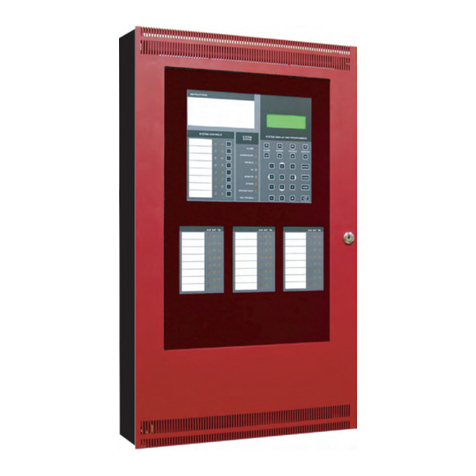
Mircom
Mircom FX-2200 Series Programming manual

Somati system
Somati system SLIDETRONIC II quick start guide
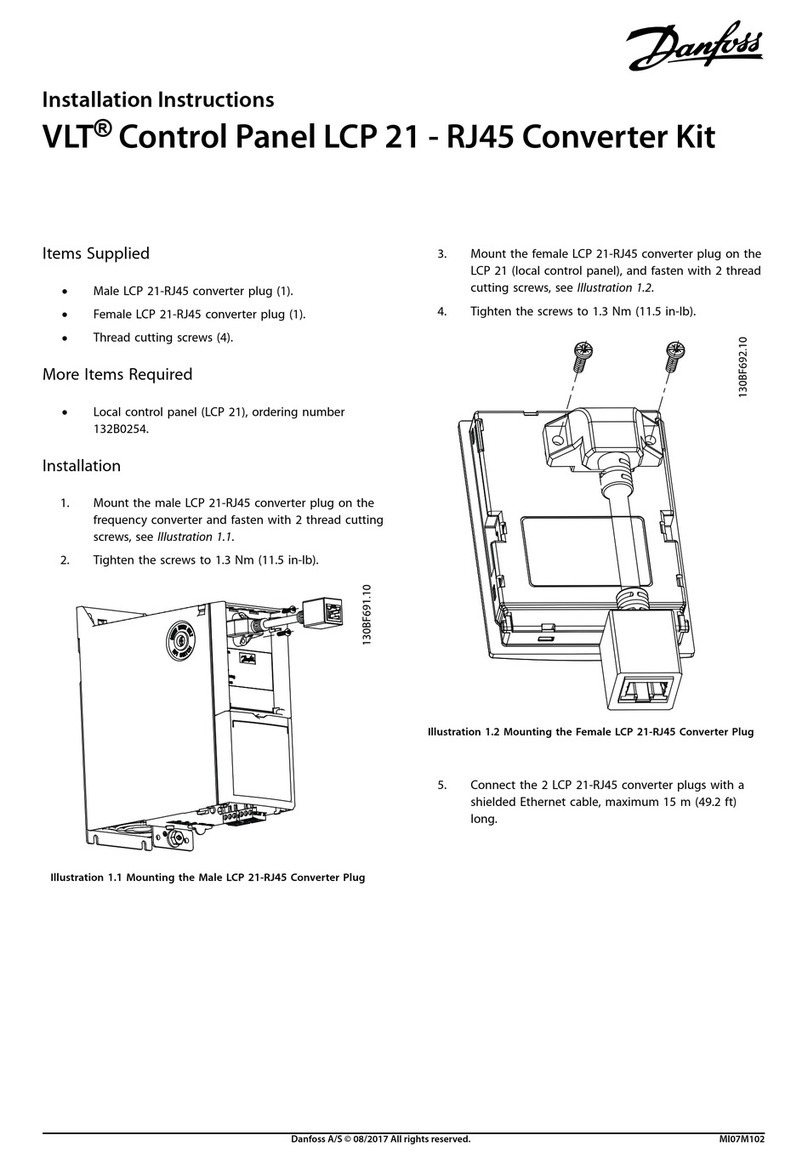
Danfoss
Danfoss VLT LCP 21 installation instructions

Flexit
Flexit SP405 user guide
